Sinc Collocation Method for Solving the Benjamin-Ono Equation
Abstract
We propose a simple, though powerful, technique for numerical solutions of the Benjamin-Ono equation. This approach is based on a global collocation method using Sinc basis functions. Some properties of the Sinc collocation method required for our subsequent development are given and utilized to reduce the computation of the Benjamin-Ono equation to a system of ordinary differential equations. The propagation of one soliton and the interaction of two solitons are used to validate our numerical method. The method is easy to implement and yields accurate results.
1. Introduction
It is well known that nonlinear partial differential equations (NPDEs) are widely used to describe complex phenomena in various fields of sciences, such as physics, biology, and chemistry.
James and Weideman [7] used the Fourier method which implicitly assumes the periodicity of the boundary conditions and a method based on rational approximating function to compute numerical solutions of the BO. The rational method was shown to have spectacular accuracy for solutions that do not wander too far from the origin while, for long dated solutions, the Fourier method was shown to retain superior accuracy. Miloh et al. [8] proposed an efficient pseudospectral method for the numerical solution of the weakly nonlinear Benjamin-Ono equation for arbitrary initial conditions and suggested a practical new relationship for estimating the number of solitons in terms of arbitrary initial conditions. Thomée and Vsaudeva Murthy [9] used the Crank-Nicolson approximation in time and finite difference approximations in space to solve the BO equation. They treated the nonlinear term in a standard conservative fashion and discretized the Hilbert transform by a quadrature formula which was computed efficiently using the fast Fourier transform. Recently, Boyd and Xu [10] compared three spectral methods for solving the Benjamin-Ono equation, Fourier pseudospectral, rational Christov functions, and Gaussian radial basis functions. They highlighted the advantages and the disadvantages of each numerical method. For instance, the Fourier pseudospectral method is very fast through use of the fast Fourier transform (FFT), but requires domain truncation which is unnecessary for a rational basis. Radial basis functions are slow for a given number of grid points; however, they have a very flexible grid adaptation. To the best of our knowledge, there are no records regarding numerical solutions of the BO equation by using Sinc numerical methods.
In this paper, we propose a Sinc collocation method for solving the BO equation. Sinc numerical methods for solving ordinary and partial differential equations have increasingly become popular and have been extensively studied, in particular, for problems on unbounded domains and those having singularity at boundaries. The first Sinc method was introduced by Stenger [11] to solve two-point boundary value problems for second order differential equations. In the field of nonlinear partial differential equations, the use of Sinc numerical methods has shown tremendous potential. For instance, Al-Khaled [12] showed the utility of the Sinc Galerkin method for solving the Korteweg-de Vries equation. Recently, Mokhtari and Mohammadi [13] presented a meshfree method based on the Sinc collocation method to solve the generalized regularized long wave equation. Excellent overviews of the existing Sinc methods for solving ODEs, PDEs, and integral equations can be found in [14, 15].
The layout of this paper is as follows. We describe the formulation of the Sinc collocation method and the discretization of the Hilbert transform in Section 2. Section 3 is devoted to the Sinc collocation discretization of the BO equation. Furthermore, we examine the stability of the method by using a linearized stability analysis. Numerical results illustrating the merits of the new scheme are given in Section 4. Finally, we present our conclusions in Section 5.
2. Sinc Collocation Methods
Lemma 1. The Hilbert transform of a function u can be approximated by
In order to state the convergence theorem of the Sinc collocation method, we introduce the following notation and definitions.
Definition 2. Let denote the infinite strip region with width 2d (d > 0) in the complex plane
One then gets the following convergence results.
Theorem 3 (see [15].)Assume, with positive constants α, β, and d, that
(1) u belongs to ;
(2) u decays exponentially on the real line; that is,
The proof of the above Theorem 3 is beyond the scope of this paper. We refer the reader to [15] for a detailed discussion. Theorem 3 states that, if u is an analytic function on an infinite strip containing the real line and allows specific growth restrictions, then it has exponentially decaying absolute errors in the Sinc approximation. Similarly, the approximation of the derivatives and the Hilbert transform of u decay exponentially.
3. Construction of the Method
4. Numerical Results
4.1. Propagation of Single Solitons
In this experiment, we consider the propagation of single solitons of the BO equation. The initial and boundary conditions are extracted from (47) and (22), respectively. The values of the parameters used in the numerical experiments are k1 = 0.3, ϕ1 = 0, θ = 1/2, the number of collocation points N = 200, and δt = 0.001. The soliton from which the initial condition is extracted (47) moves to the right across the space interval x ∈ [−100,100] when the time interval is t ∈ [0,110]. The numerical tests for this case are performed using the Sinc basis functions.
The error norms L∞, L2 and conservation quantities I1, I2, and I3 are computed, which are shown in Table 1. From the numerical results given in Table 1 it is observed that, throughout the simulation, the error norms L∞ remain less than 1.9803 × 10−4 and L2 remains less than 9.3644 × 10−4, whereas the changes of the invariant I1 are less than 10−4 and the invariants I2 and I3 at a given time t are equal to those of the initial value; our scheme is satisfactorily conservative. The numerical solutions at different time levels (a) and the absolute error (b) at time t = 110 are shown in Figure 1 for k1 = 0.3, ϕ1 = 0, θ = 1/2, the number of collocation points N = 200, and δt = 0.001 in the region x ∈ [−100,100].
| Time | L∞ | L2 | I1 | I2 | I3 | CPU(s) |
|---|---|---|---|---|---|---|
| 0 | 0 | 0 | 12.3007 | 7.5397 | 10.1788 | 0.000 |
| 10 | 3.3754E − 5 | 7.6966E − 5 | 12.3007 | 7.5397 | 10.1788 | 0.810 |
| 30 | 6.0085E − 5 | 1.8419E − 4 | 12.3008 | 7.5397 | 10.1788 | 2.098 |
| 50 | 8.5661E − 5 | 3.0307E − 4 | 12.3008 | 7.5397 | 10.1788 | 3.605 |
| 70 | 1.1471E − 4 | 4.5713E − 4 | 12.3008 | 7.5397 | 10.1788 | 5.505 |
| 90 | 1.5029E − 4 | 6.5433E − 4 | 12.3008 | 7.5397 | 10.1788 | 7.499 |
| 110 | 1.9803E − 4 | 9.3644E − 4 | 12.3008 | 7.5397 | 10.1788 | 9.931 |
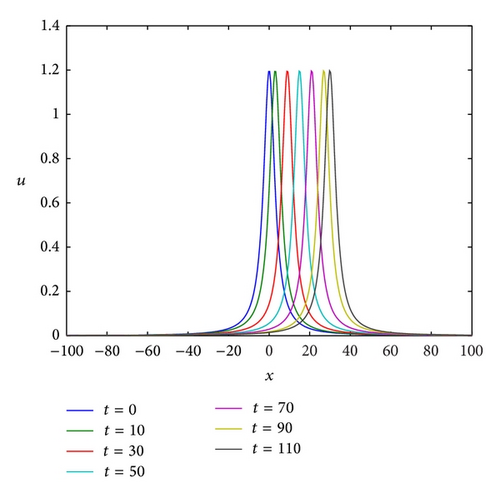
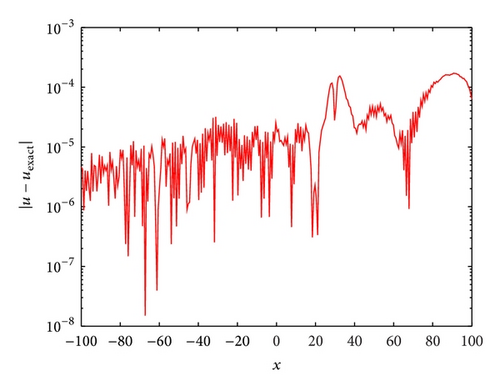
In the next experiment, we investigate the convergence of our approach in terms of the number of grid points N at time t = 1. To ensure that our scheme is not dominated by the time discretization, we choose δt = 10−5. We take the parameters such as k1 = 0.4, k2 = 0.1, ϕ1 = 30, ϕ2 = 0, δt = 10−5, θ = 1/2, and x ∈ [−100,100].
Figure 2 shows that the error norms L∞ and L2 converge exponentially for the propagation of one soliton solutions and for the interaction of two soliton solutions as we increase the number of grid points N.
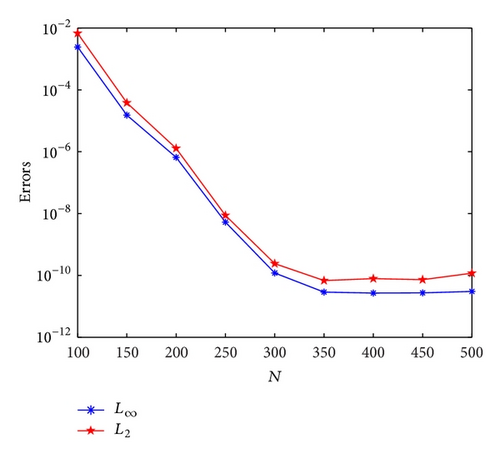
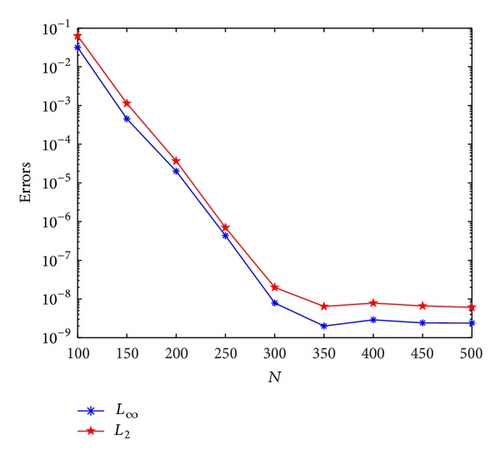
4.2. Interaction of Two Solitons
Our second experiment pertains to the interaction of two soliton solutions of the BO equation having different amplitudes and travelling in the same direction. The initial and boundary conditions are extracted from (47) and (22).
To allow the interaction to occur, the experiment was run from t = 0 to 210 in the region [−100,100]. Figure 3 shows the interaction of two soliton solutions of BO equation for k1 = 0.4, k2 = 0.1, ϕ1 = 30, ϕ2 = 0, N = 200, δt = 0.001, θ = 1/2, and x ∈ [−100,100]. It can be seen that the faster pulse interacts with and emerges ahead of the lower pulse with the shape and velocity of each soliton retained. Because of the nature of the Sinc discretization, the Hilbert transform and matrix differentiation are explicitly obtained with exponential accuracy. The result in Figure 3 shows numerical interaction of the two soliton solution and its time evolution of the L2 error from t = 0 to t = 210. In Figure 3(b), it is shown that the Sinc discretization maintains accurate results comparable to those given in [7, 10] for a long period. Therefore, a number of properties of the Benjamin-Ono equation can be checked numerically, including the exhibition of no phase shifts after interaction of the solitons.
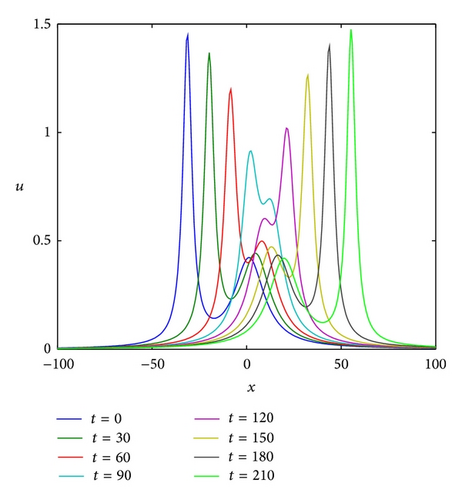
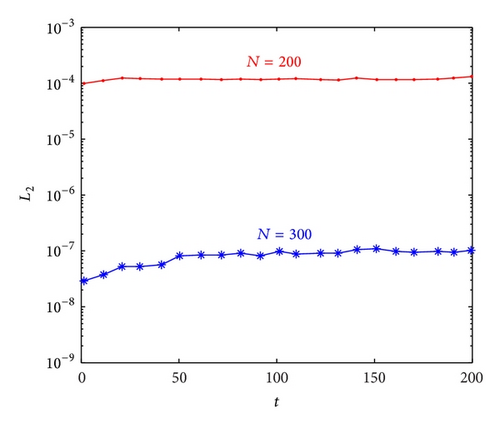
Numerical check on the conservation mass, momentum, and energy shows that the three quantities remain constant with respect to time as shown in Table 2. Propagation of the single solitary wave and two soliton integrations are simulated well with the proposed algorithms and conservation invariants do not change much during the computer run. Thus Sinc functions can be used to construct approximate numerical methods of the BO equation.
| Time | L∞ | L2 | I1 | I2 | I3 | CPU(s) |
|---|---|---|---|---|---|---|
| 0 | 0 | 0 | 24.0123 | 12.5716 | 16.7526 | 0.000 |
| 1 | 1.0200E − 4 | 1.4299E − 4 | 24.0124 | 12.5716 | 16.7526 | 0.278 |
| 30 | 2.7172E − 4 | 8.2385E − 4 | 24.0124 | 12.5716 | 16.7526 | 1.833 |
| 60 | 4.0996E − 4 | 1.4813E − 3 | 24.0124 | 12.5716 | 16.7526 | 3.854 |
| 90 | 5.6586E − 4 | 2.1770E − 3 | 24.0124 | 12.5716 | 16.7526 | 7.016 |
| 120 | 6.8573E − 4 | 2.9978E − 3 | 24.0124 | 12.5716 | 16.7526 | 8.961 |
| 150 | 8.5960E − 4 | 4.2343E − 3 | 24.0124 | 12.5716 | 16.7526 | 11.351 |
| 180 | 2.1269E − 3 | 6.6914E − 3 | 24.0124 | 12.5716 | 16.7526 | 14.142 |
| 210 | 3.1148E − 3 | 9.6304E − 3 | 24.0124 | 12.5716 | 16.7526 | 16.748 |
5. Conclusion
A numerical technique based on the Sinc collocation method has been presented for numerical solutions of the BO equation. The efficiency of the method is tested on the problems of propagation of a single soliton as well as interaction of two solitons. The accuracy of solutions is examined in terms of the L∞, L2 error norms, and the conservation quantities I1, I2, and I3. Stability analysis is performed by the matrix method. The results obtained for the Sinc collocation are very close to analytical ones. Our algorithm was found to be unconditionally stable and exponentially convergent in space and a reliable numerical method for solving the BO equation. The method is easy to implement and compares favourably to Fourier-based spectral methods without any assumptions on periodicity.
Conflict of Interests
The authors declare that there is no conflict of interests regarding the publication of this paper.
Acknowledgment
Edson Pindza is thankful to Brad Welch for the financial support from RidgeCape Capital.




